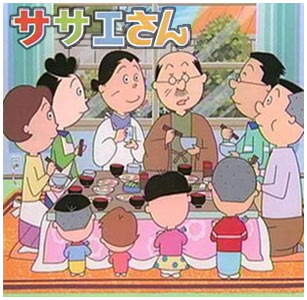Like most parents in Japan, I closely followed the interests of my kids as they were growing up. When my son went through his “train” phase during which he fell in love with Japan’s Shinkansen bullet trains, I was right there with him, learning to identify all the major train lines by sight. Girls in Japan are socially programmed to watch whatever “magical girl” anime is currently running, and when my daughter was small it was Ojamajo Doremi (aka Magical Doremi), which I watched with her for years. And ever since my kids could crawl, we all gathered in front of the TV at 6:30 pm on Sundays to enjoy Sazae-san, the story of the Isono Family including father Namihei, wife Fune, daughter Sazae, her husband Masuo and all the rest. (A running joke is that the names of every character in the show has something to do with the sea.) Sazae-san is the longest-running anime series in history, broadcast non-stop since 1969, making it one year younger than me. The only way to describe the institution of Sazae-san would be to imagine The Flintstones staying on the air forever, being loved by each new generation and enjoying regular ratings of 20% or more. I think a lot of the popularity of the show is in its simplicity: it’s about a normal, every-day family that has simple problems and misunderstandings to solve. They don’t fret about the Internet running out of IPv4 addresses or North Korea shooting Taepodong missiles or the declining birthrate, and it’s pleasant to watch, like a doorway to a simpler age.

Sazae-san has been a part of family life since 1969.















